Google still dominates the search engine space in 2025, even though many voice assistants and AI-powered platforms are getting viral these days.
The platform handles billions of searches every single day and continues to be the go-to destination for finding information online.
So far, no major shift has managed to shake Google’s position as the default tool for everyday queries.
In this article, we’ll take a closer look at Google searches per day stats to reveal how many searches Google processes daily, who’s using it, and what they’re searching for.
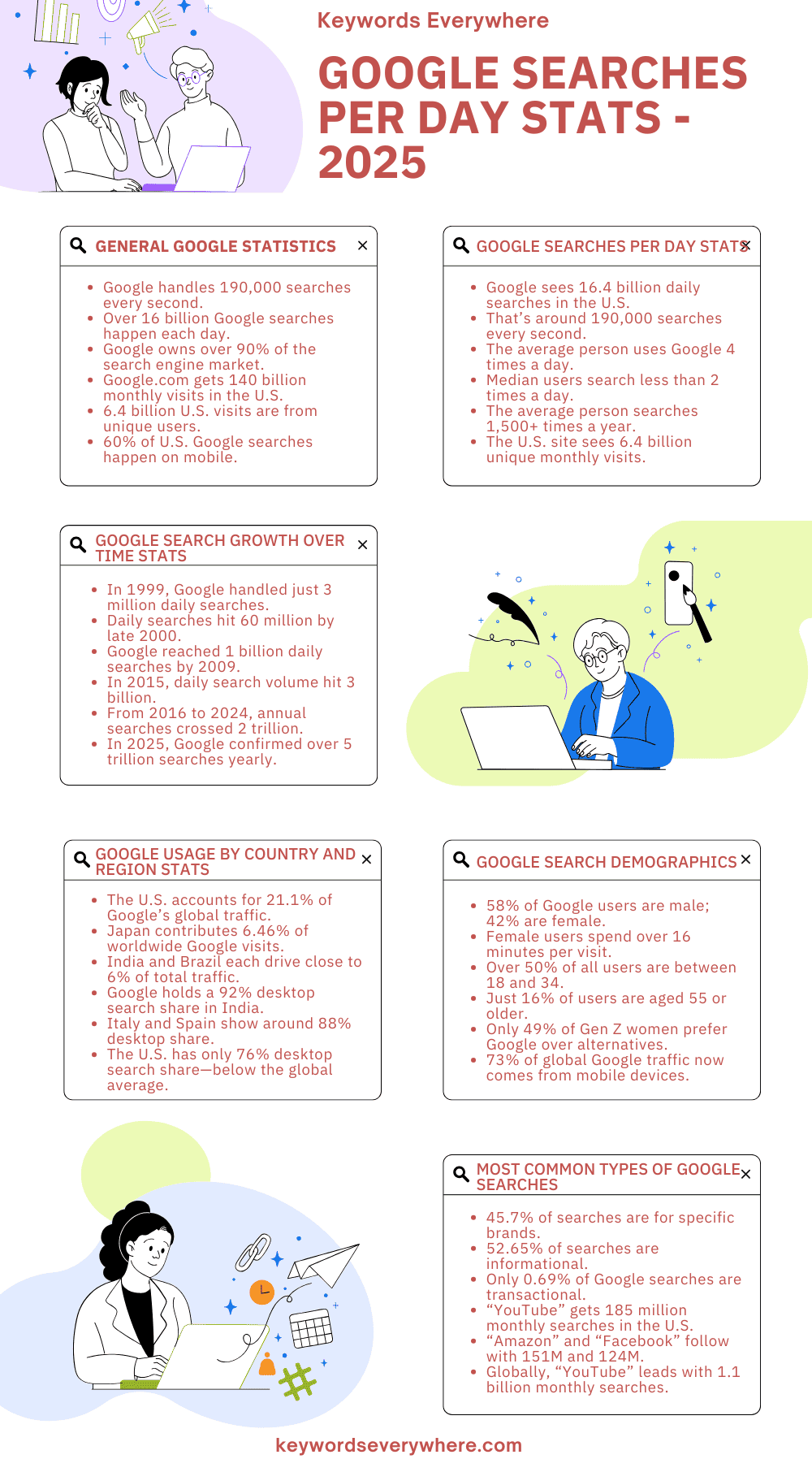
Google Search Stats (Top Picks)
Google still dominates the internet in 2025, even as new technologies try to change how we search for information.
Whether it’s asking questions, shopping, or finding directions, people rely on Google more than ever.
But just how widespread is its use, and what does the big picture look like?
Here are the top Google search stats that reveal how deeply it’s woven into daily life.
1. Google handles around 190,000 searches every second, which adds up to more than 16 billion searches every single day. That’s a whole lot of questions being asked non-stop.
2. Google controls more than 90% of the search engine market worldwide.

Google’s search dominance
3. In the U.S. alone, Google’s website gets nearly 140 billion visits each month, and around 6.4 billion of those are from different individual users.
4. More than 60% of all Google searches in the U.S. happen on mobile phones.
5. 49% of internet users are curious about AI-powered search. If you’ve ever asked ChatGPT to look something up for you, you’re not the only one.
6. On average, people visit about 7.9 pages and spend over 10 minutes when using Google, meaning it’s more than just a quick stop for most users.
7. According to Keywords Everywhere, search terms that include the word “Google” are searched millions of times each month. One example? “Google Maps” gets searched by 185 million people every month.
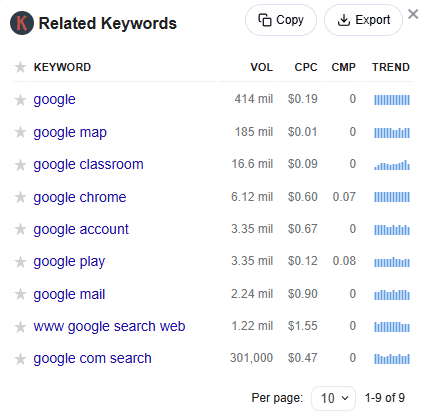
Google Searches Per Day Stats
In 1999, Google was handling just over 3 million searches per day. Fast forward to now, and the number has exploded into the billions.
With smartphones in nearly every pocket and AI making search even faster, the daily volume keeps growing.
But how many searches are happening each day—and how has that changed even in the past few years?
Below are the Google searches per day stats that show just how far we’ve come.
8. In the U.S., Google handles around 16.4 billion searches a day. That works out to roughly 190,000 searches every second or about 11.4 million every minute.
9. On average, a person uses Google about 4 times a day, but the typical (or median) user actually searches less than twice a day. That means a smaller group of users is doing most of the heavy searching.
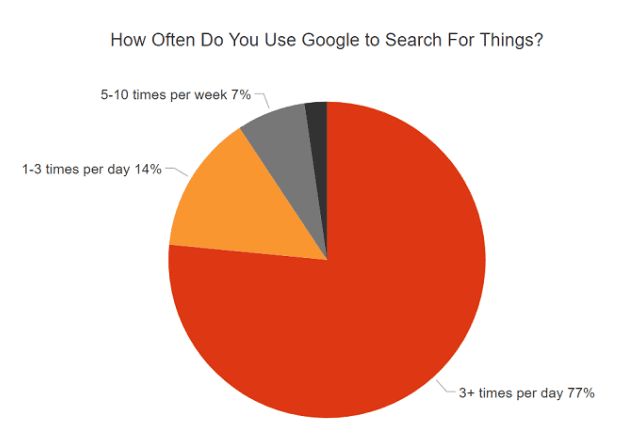
How many times an average user search on Google
10. If you break it down further, the average user makes 29 searches per week, 126 per month, and over 1,500 per year.
11. Looking at how many people visit Google each month by country, the U.S. site (google.com) sees 6.4 billion unique visits. In comparison, the UK site gets about 59 million, India sees 47 million, Germany has 38 million, and South Korea follows closely with 37 million.
12. According to Datos, more than half of U.S. Google searches end without a single click—about 58.5% are “zero-click” searches. In the EU, it’s even a bit higher, with almost 60% of searches not leading to any clicks at all.
13. Google’s search index—the system it uses to store all the content it finds online—is over 100,000,000 gigabytes in size.
14. A growing feature called AI Overviews now shows up in more than 13% of all Google searches. That’s a big jump from earlier in the year, when it appeared in just over 6% of queries.
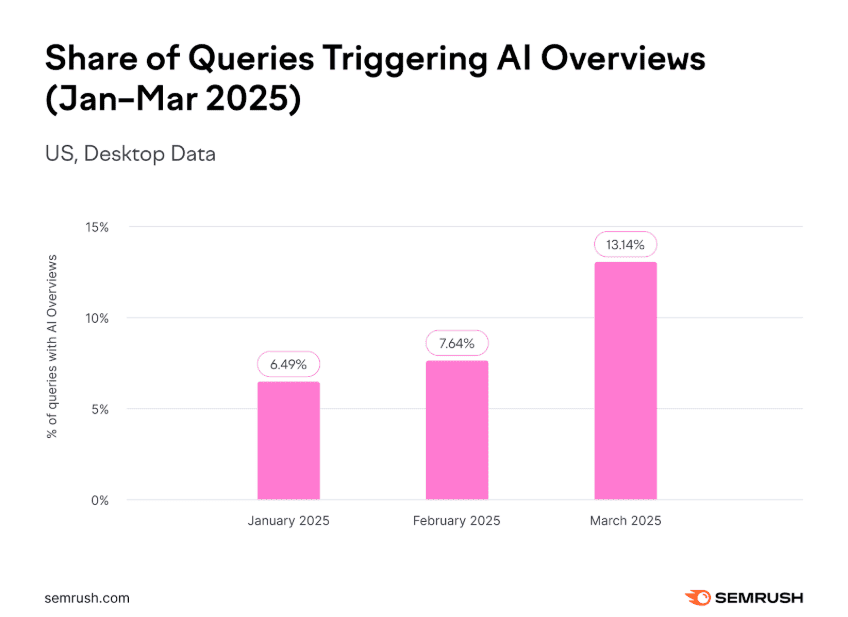
Share of Google searches triggering AI overviews
15. Each AI Overview usually includes about five links to different sources, and over half of those links are also found in the regular top 10 search results.
Google Search Growth Over Time
Google’s growth hasn’t just been steady—it’s been explosive.
What started with a few thousand queries has evolved into a cultural habit millions depend on every hour.
Looking at how search volume has changed over the years tells us a lot about how the internet and our daily lives have evolved.
Here are the Google searches per day stats that highlight Google’s rise and reveal where things might be headed next.
16. Back in 1999, Google was handling just 3 million searches a day, which added up to around 1 billion searches for the whole year. That was the early internet, and Google was just getting started.
17. In 2000, daily search traffic picked up fast, starting with 18 million a day and jumping to 60 million by the end of the year. That brought the yearly total to an estimated 14 billion searches.
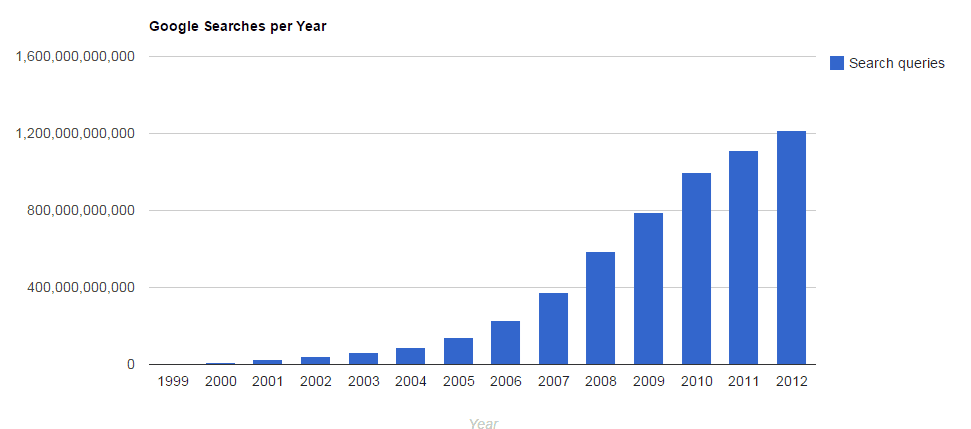
Google searches per year 1999-2012
18. Between 2001 and 2003, Google’s search volume passed 55 billion per year, as reported in their annual “Zeitgeist” summaries during those years.
19. From 2004 to 2008, Google shared fewer numbers, but in 2004 they reported 200 million searches per day, bringing the yearly total to roughly 73 billion. After that, they described search volume as “in the billions.”
20. By 2009, things skyrocketed. A Google blog post confirmed the platform was handling over 1 billion searches a day, pushing the yearly estimate to more than 365 billion.
21. Between 2012 and 2015, Google revealed it was processing about 100 billion searches per month, which works out to around 1.2 trillion searches a year. They mentioned this again in 2015, noting about 3 billion searches per day.
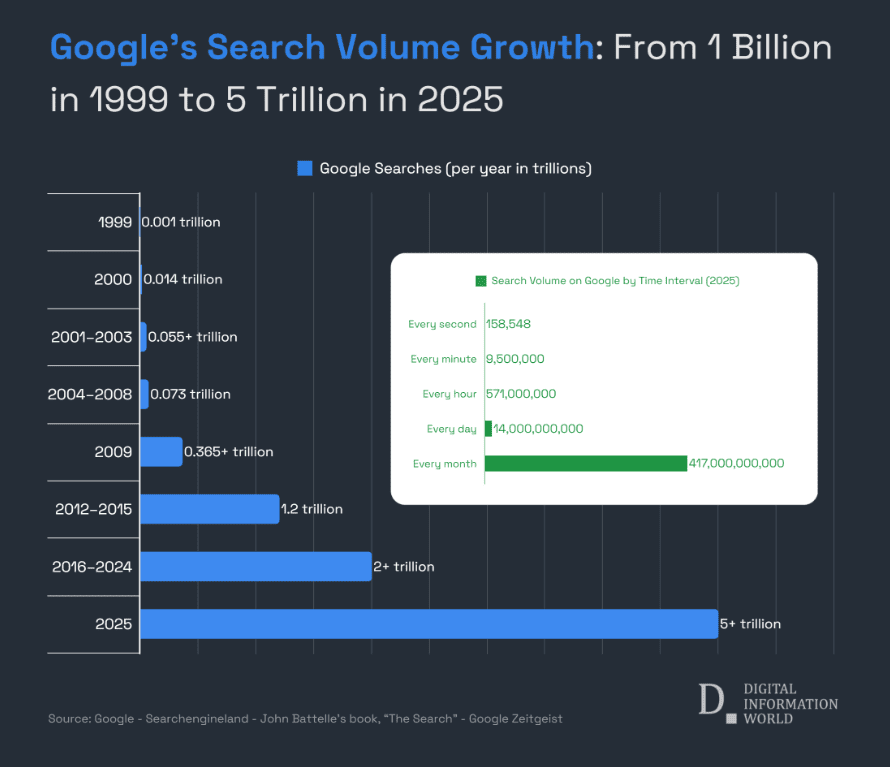
Google search volume growth 2025
22. From 2016 through 2024, Google began using the word “trillions” to describe its annual search traffic. Experts estimated that meant at least 2 trillion searches per year globally.
23. By 2025, Google confirmed through its blog that search volume had crossed 5 trillion searches annually.
Google Usage By Country and Region
Not every country uses Google in the same way.
In the U.S., it holds more than 90% of the search market, but countries like China and Russia lean toward local alternatives. Meanwhile, India is quickly becoming one of Google’s biggest markets thanks to mobile-first internet access.
Here are the Google searches per day stats that show where in the world search demand is rising fastest.
24. As of May 2025, the U.S. brought in the most Google traffic, making up 21.1% of all visits over three months. That means one out of every five visits to Google came from the United States.
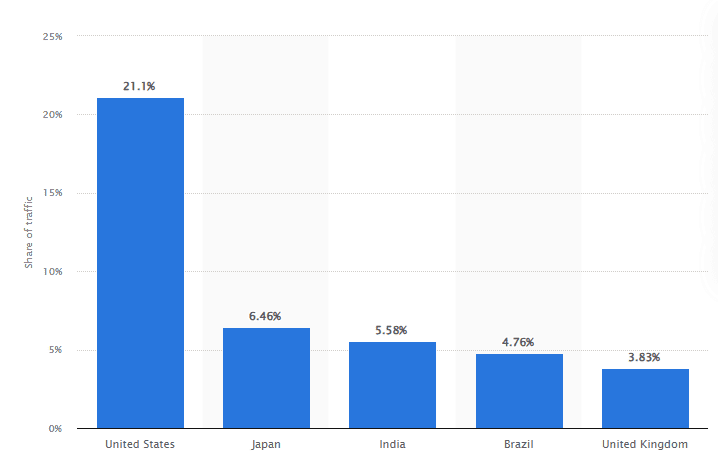
Desktop traffic to Google.com by country
25. Japan came next with just over 6.46%, followed closely by India and Brazil, each contributing close to 6% of global Google traffic.
26. Interestingly, some countries with large populations—like Pakistan and Nigeria—don’t make the top of the list. That’s mostly because less than half of their populations have regular internet access, which keeps their share of Google traffic low.
27. Google may be the top search engine worldwide, but its desktop market share isn’t the same everywhere. In India, it dominates with over 92% of desktop searches, while countries like Italy and Spain also show strong numbers at around 88%.
28. Meanwhile, even though the U.S. sends the most traffic to Google, it falls below the global average for desktop search share. About 76% of desktop searches in the U.S. happen on Google, compared to a worldwide average of nearly 82%.
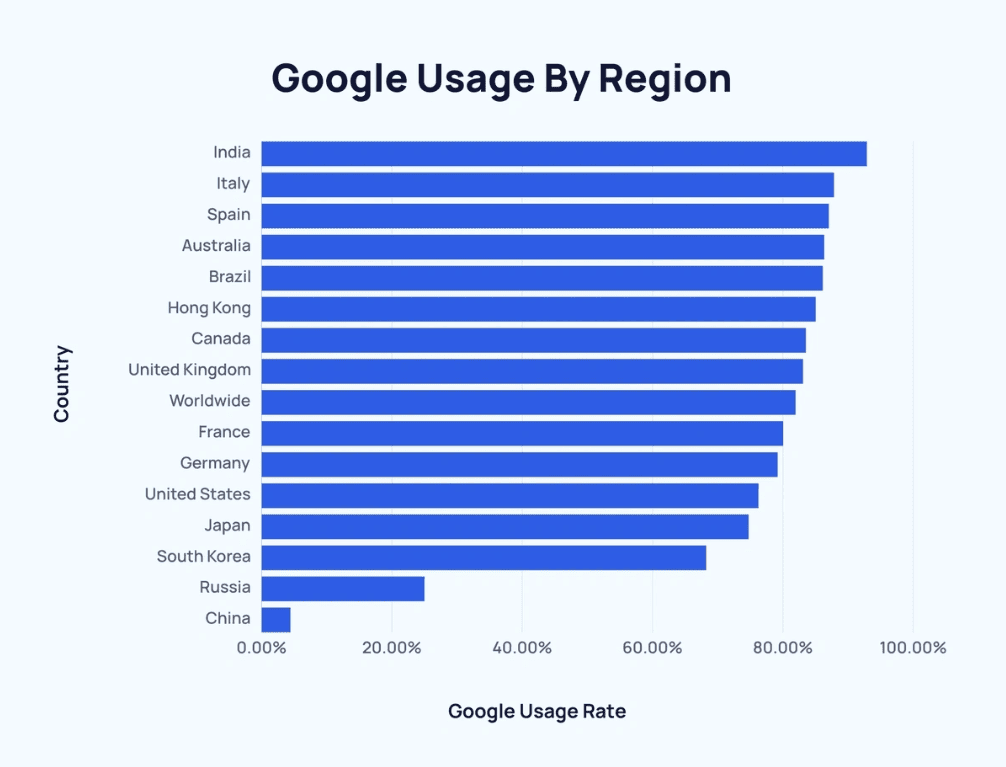
Google usage by region
Google Search Demographics
Who’s really using Google every day? It’s not just teens or tech workers.
From Gen Z students to retirees checking weather updates, Google’s audience cuts across every age group.
Still, younger users tend to search more frequently, and mobile use dominates among certain demographics.
Below are the Google searches per day stats that reveal who’s turning to Google—and how often.
29. Men make up a bigger share of Google users, with nearly 58% of traffic coming from male visitors, while about 42% comes from women.
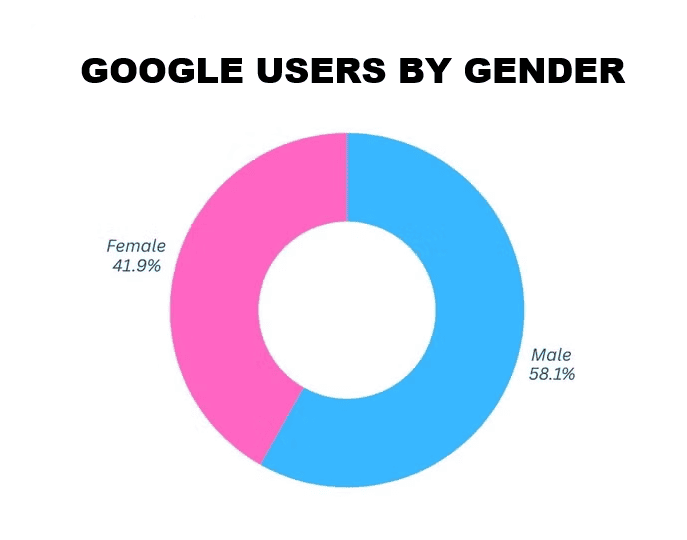
30. On average, female users stay on Google longer—over 16 minutes per visit, compared to around 15 minutes for male users. They also view more pages and are slightly less likely to leave right away.
31. Young adults dominate Google’s user base, with more than half of all visitors falling between the ages of 18 and 34. In contrast, only about 16% of users are 55 or older, showing that search habits really vary by age.
32. Among Gen Z women, only 49% say Google is their go-to search tool. The rest? Many are turning to platforms like TikTok instead to find answers, ideas, or recommendations.
33. Most people now use Google on their phones, with nearly 73% of global traffic coming from mobile devices. That leaves less than 30% coming from desktops, proving that mobile-first really is the norm.
34. In the U.S., over 1 in 5 people search online for a local business every single day, and nearly a third do this multiple times a week.
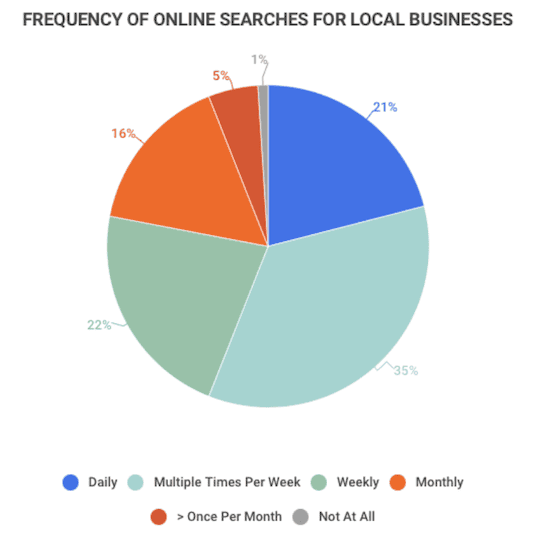
Frequency of online searches for local businesses
35. When it comes to maps, Google Maps is the clear favorite, with 88% of users choosing it over Apple Maps, which only has 12% of the share. Businesses follow that same trend, optimizing their listings where the audience actually is.
36. Google Lens is growing fast, too. People now use it for 12 billion visual searches every month, and that number has quadrupled since 2021.
Most Common Types of Google Searches
Since Google answers almost every query, different people search for different things on this search engine every day.
Some people are looking for quick answers, others want to read product reviews, while there are many who need directions.
Interestingly, “how to” searches have exploded over the past decade, and entertainment-related queries spike every time a major show or event hits.
Here are the Google searches per day stats on the most common types of searches people make every day.
37. 45.7% of all Google searches are for brands, according to a survey by Datos. That means nearly half of users are searching for a specific company, website, or product they already have in mind.
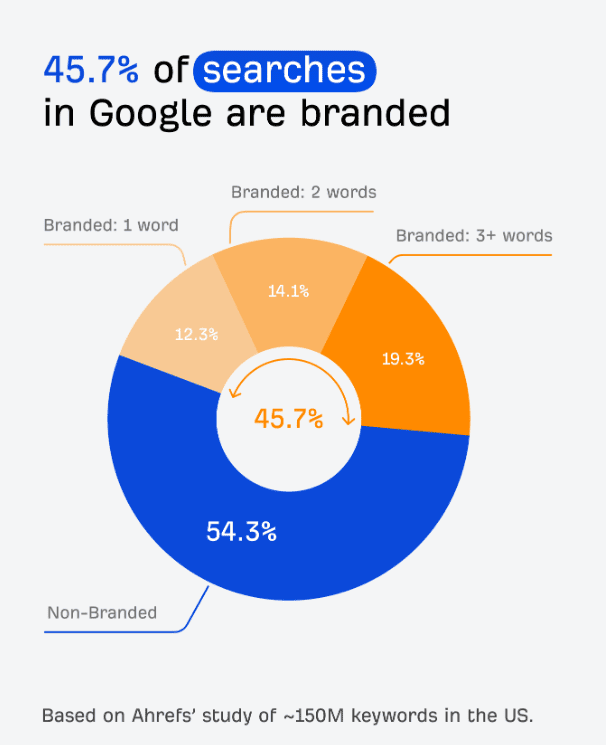
Majority of Google searches are branded
38. Most Google searches (52.65%) are informational. People are usually trying to learn something, look up facts, or get quick answers—not necessarily make a purchase.
39. Only 0.69% of searches are transactional, meaning very few people go to Google specifically to buy something or sign up for a service right away.
40. In the U.S., the most searched terms are a mix of popular websites, daily needs, and useful tools.
Here are the top 10 Google searches in the United States:
| Keyword | Search Volume |
| YouTube | 185,000,000 |
| Amazon | 151,000,000 |
| 124,000,000 | |
| Weather | 83,100,000 |
| 68,000,000 | |
| Gmail | 55,600,000 |
| Wordle | 55,600,000 |
| Google Translate | 45,500,000 |
| Food Near Me | 37,200,000 |
| Home Depot | 37,200,000 |
41. Globally, the top searches are led by big platforms like YouTube, Facebook, and WhatsApp—with billions of queries each month.
Here are the top 10 Google searches worldwide:
| Keyword | Search Volume |
| YouTube | 1,100,000,000 |
| 670,400,000 | |
| WhatsApp Web | 520,700,000 |
| Translate | 428,800,000 |
| 406,600,000 | |
| 386,300,000 | |
| Amazon | 384,000,000 |
| Gmail | 378,400,000 |
| Weather | 312,800,000 |
| Google Translate | 289,800,000 |
Conclusion
Google continues to be the center of how people explore the internet, and the stats make it clear—it’s still the most powerful tool for driving online visibility.
Even with new platforms and AI reshaping how we search, Google’s dominance hasn’t really changed.
For now, AI-powered tools may be growing fast, but they haven’t put a dent in Google’s global search stronghold.


